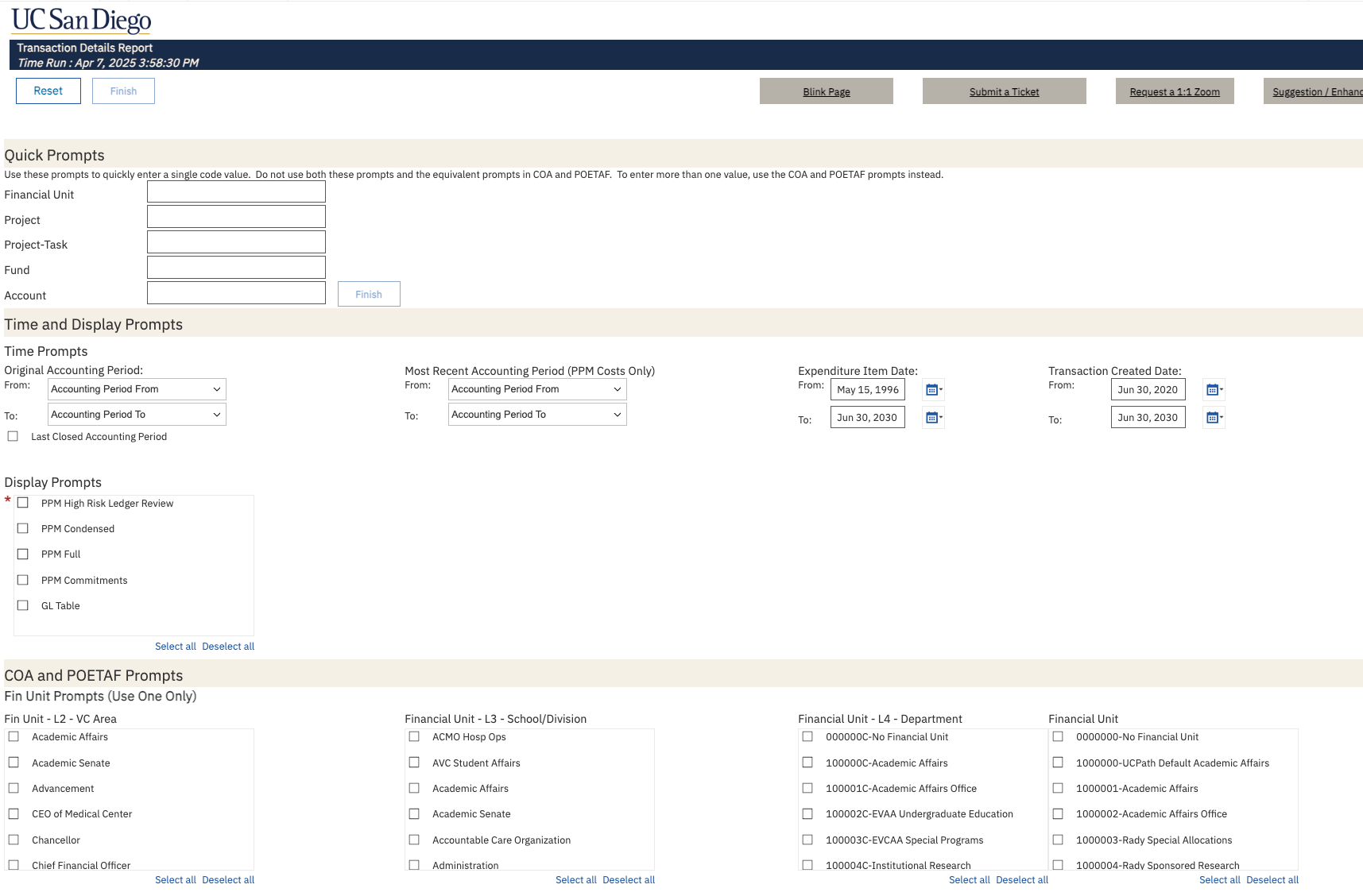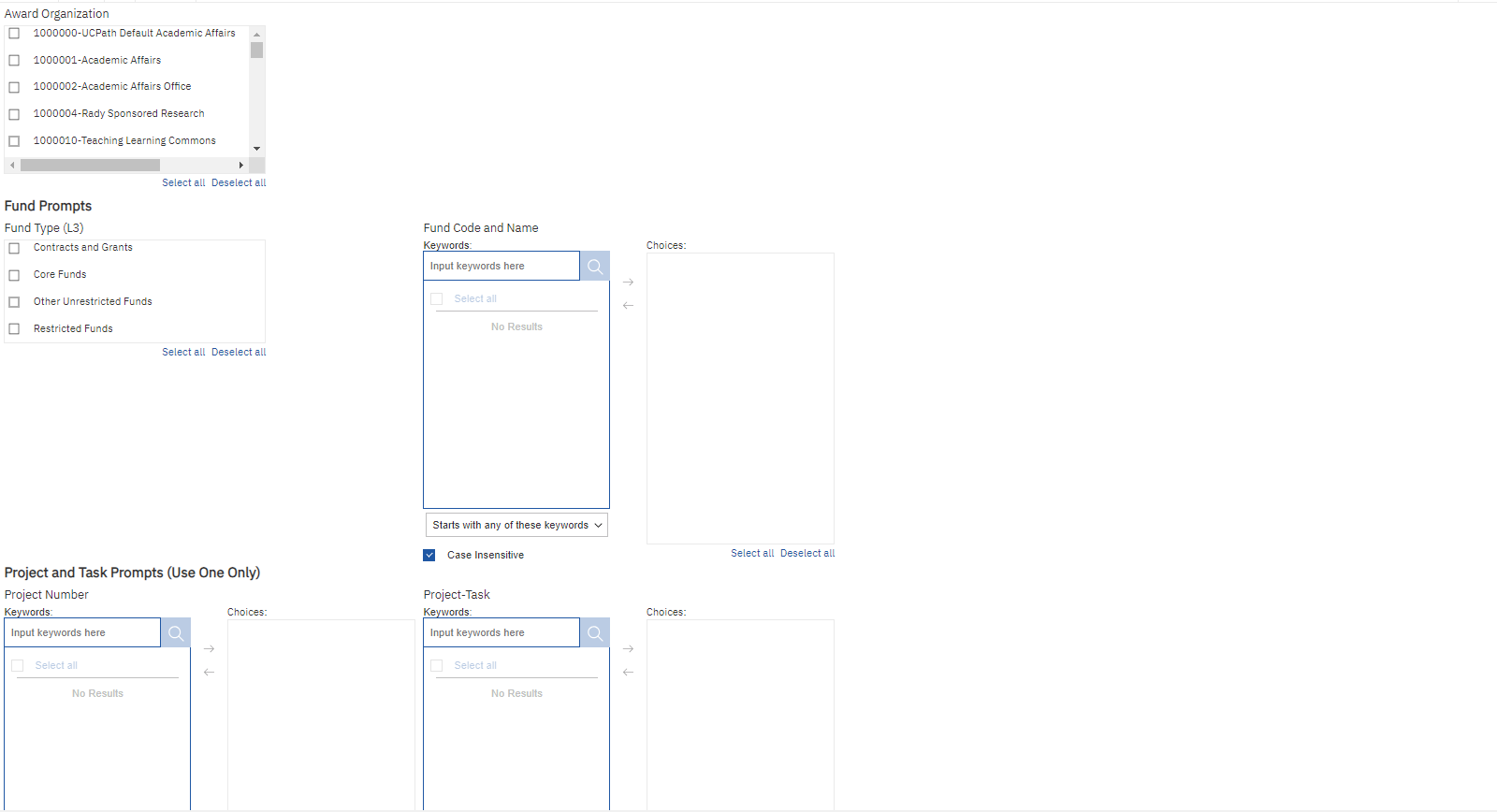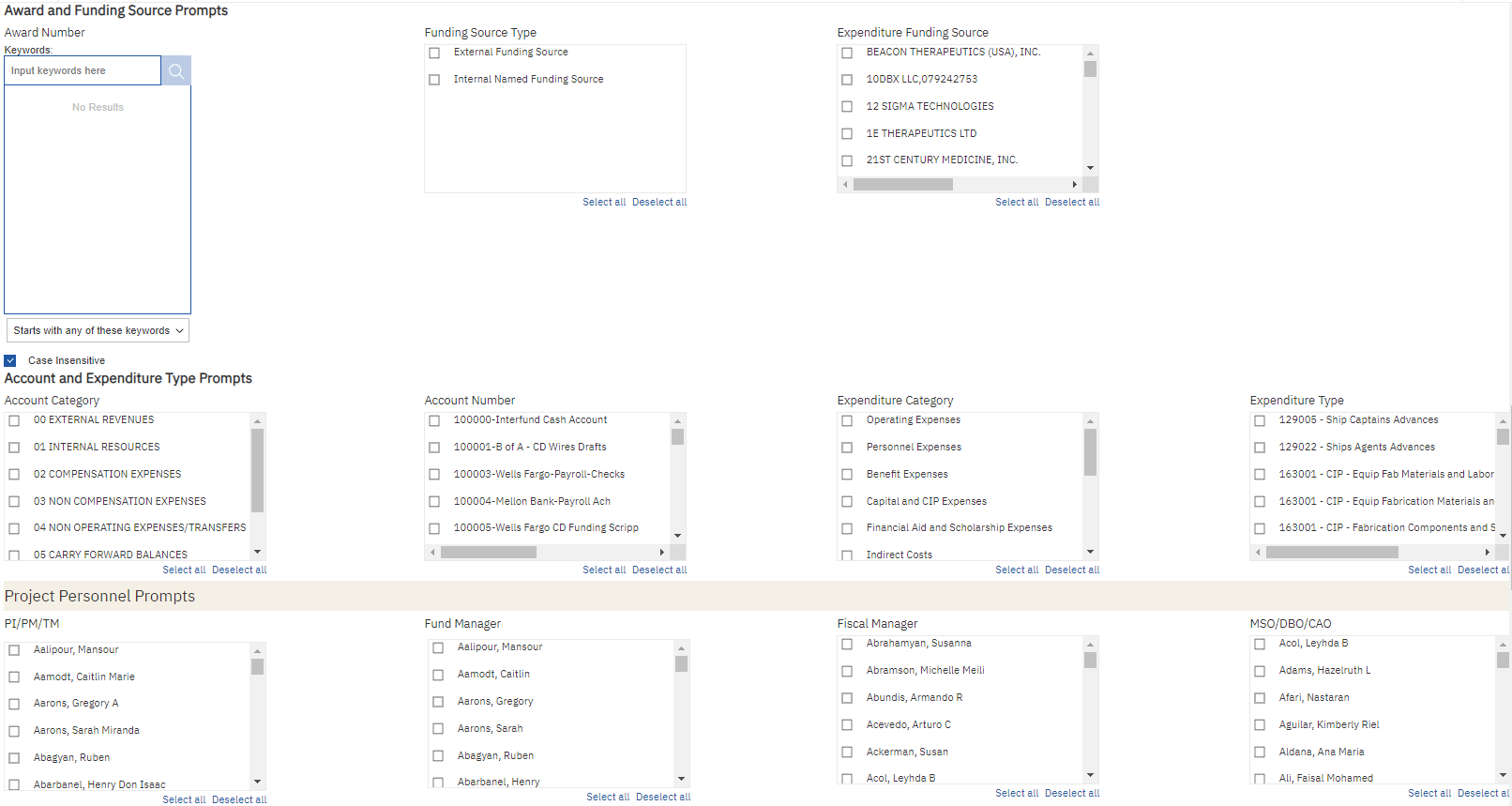Transaction Details Report
Last Updated: July 24, 2025 10:04:10 AM PDT
Give feedback
The Transaction Details report provides detailed information about transactions posted to the Oracle General Ledger and PPM subledger. It also provides detailed information about outstanding PPM Commitments.
The Transaction Details report is available from the Business Analytics Hub (bah.ucsd.edu) under the Financial Management tab.
The dashboard includes:
- High Risk Ledger Review
- PPM Costs (Full)
- PPM Costs (Condensed)
- PPM Commitments
- GL Transactions
You can find the Transaction Details Report Demo on the Budget & Finance MediaSpace channel - Financial Report Demos playlist.
Access
Access has been provisioned to anyone with the Oracle BI Consumer JR role. Staff who do not have access should request the Oracle role. Access failure appears as error "Unable to load requested view. Displaying home view instead."
- Navigate to bah.ucsd.edu.
- Select Budget & Finance.
- If using the List View, look for Transactions Details in the list or use the search bar at the top right and click the dashboard name
- If using the Card View, click the Financial Management tab and click Launch on the Transaction Details tile
- Use your Active Directory credentials to sign in, if prompted.
Navigation
The Cognos and Oracle Tips & Tricks page shares various recommendations on navigating report functionality
- Use these parameters to filter for the data you want to view
- These filters can be used in combination or individually to produce desired results
- Use the ‘Quick Prompts’ section to quickly enter a single value for Financial Unit, Project, Project-Task, and/or Fund.
Time and Display Prompts
| Prompt | What to Know |
|---|---|
| Original Accounting Period |
|
| Last Closed Accounting Period |
|
| Most Recent Accounting Period |
|
| Expenditure Item Date |
|
| Transaction Creation Date |
|
| Display Reports |
|
COA and POETAF Prompts
| Prompt | What to Know |
|---|---|
| Financial Unit Prompts |
|
| Project Number |
|
| Project-Task |
|
Project Personnel Prompts
| Prompt | What to Know |
|---|---|
| PI/PM/TM |
|
| Fund Manager |
|
| Fiscal Manager |
|
Project Attribute Prompts
| Prompt | What to Know |
|---|---|
| Unless noted otherwise on the prompt page, use of these prompts will eliminate project 0000000 – no project. | |
| Project Department Reporting Category |
|
Transaction Details Prompts
| Prompt | What to Know |
|---|---|
| Net Zero Item |
|
| Transaction Number |
|
- This report displays accounting signage. Positive numbers are debits and negative numbers are credits.
- The following fields exist only for PPM transactions, and therefore use of these prompts will only produce results for the PPM High Risk Ledger Review, PPM Full, PPM Condensed reports:
- Project-Task
- Net Zero Flag (Y/N),
- Funding Source Type,
- Expenditure Category,
- Expenditure Type,
- Expenditure Comment,
- Funding Source Name.
Screenshots of the prompt page

PPM Cost Transactions
Summary
The PPM Full table includes award, project, and task information in addition to the risk types associated with each transaction.
Business Scenarios
| Business Scenario | How to |
|---|---|
| What transactions have been moved off of my project? | Net Zero Item - select "Y" for this filter to view all of the transactions that have been transferred off of your project in the PPM Transactions tab. |
| What are the invoice details for this transaction? | Drill down on the invoice number in the PPM Transactions tab to be redirected to the invoice details in Oracle. |
| Did all of my Recharge MCI file submissions post? | To review the recharge recovery (credit), filter by account 775000 - Internal Recharge Credit. The customer (debit) billings will generally utilize the 770000 - Sales and Services Activity Recharge Debit account |
| Where did this transaction I know very little about post in the ledgers? | Use the “Expenditure Comments” prompt when you don’t have a transaction number, but have some details about the expense that may be used in the expenditure comments. For example:
|
Report Views
Cost Transfer Fields
The report allows users to identify transactions that are a part of a cost transfer by introducing the following fields: Adjusted Transaction Number, Transferred from Transaction Number, Transferred from Project and Task, and Net Zero Flag.
The report table illustrates how the original transaction, reversal transaction, and new transaction are displayed in the report:
| Description | Project | Transaction Number | Amount | Transferred From Transaction Number | Transferred from Project and Task | Transferred to Transaction Number | Transferred to Project-Task Code | Adjusted Transaction Number | Reversal Transaction Number | Net Zero Item |
|---|---|---|---|---|---|---|---|---|---|---|
|
Original Transaction |
A | 123 | $100 | 789 | B | 456 | Y | |||
|
Reversal Transaction |
A | 456 | -$100 | 123 | Y | |||||
|
New Transaction |
B | 789 | $100 | 123 | A | N |
Refer to the Data Glossary for searchable data descriptions and usage rules. More information about Cost Transfers can be found on the Cost Transfers Blink page.
PPM Commitments
Summary
The PPM Commitment Details tab is a single space where users can view outstanding PPM Commitments. This report does not include commitments where the total amount for the Project, Task, Funding Source, Expenditure Type, and Expenditure Item Date combination is $0.
Business Scenarios
| Business Scenario | How to |
|---|---|
| What are the outstanding PPM Commitments for my project? | To review all outstanding PPM Commitments on a project, select “PPM Commitments” as the report to display, leave date search options as is (do not select periods), and filter for the project number. Note: Do not select any other reports if date search options are left blank as this could result in a longer run-time. |
GL Table
Summary
The GL Transactions tab is a single space where users can view transactions that hit all ledgers: the General Ledger and each Subledger (PPM, Payables, Receivables, Cash Management).
Transaction Number:
- For PPM, this is the PPM transaction number
- For GL, Transaction Number is a multipurpose field based on the source:
- Payables: Invoice or Payment Number
- Receivables: Invoice or Receipt Number
- Projects: PPM Transaction Number
Business Scenarios
| Business Scenario | How to |
|---|---|
| What are all of the transactions associated with my receipt in the GL? | Transaction Number - enter the receipt number into this filter to pull back all transactions associated with the receipt in the GL Transactions tab. |
| Who do I contact about an issue with a GL transaction? |
The Journal Source on the GL Transactions tab tells you which subledger or other source the transaction came from. Use this field to determine which department to reach out to if you have questions about your transaction. (e.g. if the Journal Source is 'Payables', submit a ticket to IPPS. If the Journal Source is 'Receivables', reach out to Financial Operations. If the Journal Source is 'UCSD UCPath', submit a ticket to the UCPath team). Transactions with a journal source of 'Manual' or 'Spreadsheet' are posted to the GL via a journal. For subledger accounting transactions, the 'Journal Created By' field may not include contact information. For more information about identifying contacts for subledger transactions, visit KBA KB0035628. |
| Which transactions posted to the GL without a project number? | Search by project number '0000000' to view all of your transactions that posted to the GL without a project number. The PPM Transactions tab will not display any data - skip to the GL Transactions tab to view your results! Submit a non-salary cost transfer data request to move non-payroll items to a project. For payroll transactions, perform a Direct Retro. |
PPM High Risk Ledger Review
Summary
The High Risk Ledger Review provides a mechanism for departments to select transactions for periodic review. This is an acceptable alternative to reviewing 100% of transactions.
Report Demo: You can view the High Risk Ledger Review report demo for a walkthrough of one approach to reviewing transactions.
Best Practice: Download report to Excel to make notes as to whether transactions are okay or require additional follow-up, as well as provide justification for charges that are questionable but acceptable.
A high risk transaction is determined by meeting one or more of the criteria below.
| Risk Type | Definition | Objective | What to Do |
|---|---|---|---|
|
Equipment under dollar threshold |
Expenditure type starts with 163003 (Capital Equipment) and the total invoice amount is less than $5,000 | Identify expense items that have been misclassified as assets |
Look at the line item description to identify what was purchased. If the purchase does qualify as equipment (acquisition cost => $5,000 and useful life > one year), then okay. If the item is not equipment, complete and submit the Subledger Transaction Correction Form. Select 'Payables Invoices or Payables Payments' from the dropdown menu, and then complete the Accounts Payable Cost Correction Request Excel spreadsheet.
|
|
High dollar invoice |
Transaction amount is more than $2,500 | Ensure purchase was appropriate, item was received, and was properly charged |
Subaward invoices and Concur Travel and Expense invoices are reviewed and approved prior to posting in Oracle. These invoices should be reviewed at a high level to ensure the charges belong on the project. For example, verify the traveler or reimbursement recipient is associated in some way with the project being charged. Full transactional review is not required. Transactions that are not subcontracts or Concur transactions perform the following:
|
|
Recharge |
Expenditure type starts with 770000 or contains "bookstore" |
Identify recharges that posted to the wrong project or were charged by a person not associate with the project. Ensure these costs belong to the project and task and that proper documentation can be obtained in case of audit on these expenses |
Note: For routine recharges such as water cooler rental and mail charges on non-sponsored projects, a less detailed review may be appropriate. |
|
Transaction posted after project end date |
Accounting date is after the project end date |
Identify costs that were incurred after the project end date and are therefore unallowable to the award. |
|
|
Fabrication cost not on a fabrication project or task |
Expenditure type starts with 163001 and neither the project nor the task contain the word "fab" |
Identify transactions miscategorized as equipment fabrication. Inappropriate use of this expenditure type can have IDC implications. |
|
|
Questionable expenditure type on a sponsored project |
Expenditure type appears in the questionable expenditure type list defined by SPF and the project is a sponsored project |
Verify that transactions are properly accounted and allowable on the award. Allowable charges may require additional justification. |
|
|
Misposted Cost Sharing |
An external funding source was used with a cost share project or task, or an internal funding source was used with a non-cost share project or task. Cost share project or task defined as one with a burden schedule starting with 'INT.' |
Identify and correct transactions that have a mismatch between the funding source and the burden schedule |
|
Business Scenarios
| Business Scenario | How to |
|---|---|
| What are my high risk transactions for this year? | Run the “PPM High Risk Ledger Review” report for all accounting periods you would like to review. Then, select a fin unit or person role to review. |
Release Notes & Communications
| Date | Release Notes & Communications |
|---|---|
| 4/8/2025 Budget & Finance Weekly Digest |
Enhancements:
|
| 12/10/2024 Budget & Finance Weekly Digest |
|
| 8/13/2024 Budget & Finance Weekly Digest |
|
| 3/12/2024 Budget & Finance Weekly Digest |
|
| 12/12/2023 Budget & Finance Weekly Digest |
We have made significant enhancements to the Transaction Details report that will improve the user experience. Changes to look out for:
Prompt page redesign Changes were made to modernize and standardize the look and feel of the prompt pages across all financial Cognos reports. Specific changes that were made include:
You can watch a report demo of these enhancements here (beginning to min 35:00) |
| 8/29/2023 Budget & Finance Weekly Digest |
The Budget and Finance User Group (BFG), including representatives from Audit & Management Advisory Services (AMAS) and Internal Controls & Accounting (ICA), has approved a change to the threshold of transactions that need to be reviewed with high-risk ledger review. The $2,500 threshold that has been applied to the total invoice dollar amount will now be applied at the transaction level. This will greatly reduce the number of transactions requiring review and simplify the monthly high-risk ledger review process. This change is now reflected in the Transaction Details report. |
| 5/9/2023 Budget & Finance Weekly Digest |
Project Department Reporting Category (Faculty Controlled vs Department Controlled) has been added as a multi-select prompt and as a field in the PPM Cost Transactions Full report and the GL Transactions report. |
| 4/11/2023 Budget & Finance Weekly Digest |
The following enhancements have been made to the Transaction Details report:
|
| 11/15/2022 Budget & Finance Weekly Digest |
The following changes are now live on the Transaction Details Report:
|

